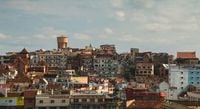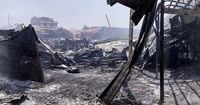Smoke still rises from the charred remains of a shopping complex in Antananarivo, a stark reminder of the turmoil that has gripped Madagascar for the past three weeks. What began as a youth-led outcry against water and electricity outages has spiraled into the largest wave of unrest the island nation has seen in years, shaking the government of President Andry Rajoelina and drawing international concern.
The movement, calling itself "Gen Z Madagascar," first took to the streets on September 25, 2025. The initial spark? Chronic blackouts and dry taps. But as days passed and frustrations mounted, the focus of the protests broadened dramatically. According to AP News, demonstrators soon voiced anger over widespread poverty, soaring living costs, limited access to higher education, and accusations of corruption and embezzlement by officials and their associates.
The protests quickly gained momentum, with thousands—mostly young people, many dressed in black—marching through Antananarivo and other cities. Civic groups and trade unions joined in, lending heft and legitimacy to the movement. As the unrest worsened, authorities imposed nighttime curfews in the capital and other urban centers, but the crowds refused to disperse.
By the first furious days, tragedy had already struck. The United Nations reported at least 22 people killed and more than 100 injured in the chaos, a toll that included protesters, bystanders, and victims of looting and violence by groups not associated with the demonstrations. The government, for its part, rejected these numbers but offered no alternative figures. UN Secretary-General António Guterres expressed his deep sadness at the loss of life and destruction, urging the authorities to abide by international human rights law. "The Secretary-General also underscores that protests must take place in a peaceful manner, respecting life, property and the rule of law, and calls for dialogue towards forging a constructive path forward," said UN spokesperson Stéphane Dujarric on Wednesday.
President Rajoelina, 51, found himself in a familiar position. He first rose to prominence in 2009 as Antananarivo’s mayor, leading protests that ended in a military-backed coup and the ouster of then-President Marc Ravalomanana. This time, however, he is the one facing the fury of the streets. Elected president in 2018 and re-elected in 2023 in a vote boycotted by opposition parties, Rajoelina’s legitimacy has been increasingly questioned by a generation that feels left behind.
In an effort to quell the unrest, Rajoelina fired his government and, in a move widely seen as an attempt to tighten control, appointed Army General Ruphin Fortunat Zafisambo as the new prime minister. He also named new ministers for defense, public security, and the gendarmerie, instructing them to "restore peace so that everyone can resume their daily lives," as reported by Reuters. Yet, these steps failed to sway the demonstrators. The Gen Z Madagascar group, mobilizing through a website, Facebook page, and a GoFundMe campaign, declared a major strike and stayaway for Thursday, October 9, and flatly rejected the president’s offer of talks scheduled for Wednesday, October 8.
"We do not reach out to a regime that every day crushes those who stand up for justice. This government talks about dialogue but rules with weapons," the group said in a statement. Another post on their verified Facebook page was even more pointed: "We reject this mockery of dialogue. We refuse the president’s invitation to talks. We will not engage in dialogue with a regime that represses, assaults, and humiliates its youth in the streets." Their demands have escalated: Rajoelina’s resignation, a public apology, and the dissolution of both the senate and the election commission.
The symbolism of the movement is as striking as its rhetoric. Protesters have adopted a pirate skull and crossbones logo, inspired by the Japanese comic One Piece, but with a Malagasy twist—a traditional hat perched atop the skull. The image, which also featured in Gen Z-led uprisings in Nepal and elsewhere, has become a rallying cry for a generation that feels it is fighting for its future in a world run by the old guard.
The government’s response has been a mix of overtures and force. While Rajoelina called for a "national dialogue"—inviting spiritual leaders, students, and youth representatives—police dispersed about 200 medical students attempting to march after a sit-in at Antananarivo’s main hospital. The president himself seemed to acknowledge the disconnect: "I don’t want flattery. I want to hear the truth. It’s the people who kept telling me that everything was fine who are responsible for our current situation," he told attendees at the talks, according to Reuters.
Yet, many in the streets see little hope for genuine reform. Maminira Ranoelisoa, whose husband Alain Mamisoa Randriambolamanana was shot dead on the first day of protests, told Reuters, "It is normal for the people to protest because the people are hungry." Her words echo the World Bank’s stark assessment: around 80% of Madagascar’s 31 million people live in severe poverty, and the country’s per capita GDP has plunged by 45% since 1960.
The economic backdrop is indeed grim. Madagascar’s fragile, export-driven economy—best known for producing most of the world’s vanilla, but also reliant on nickel, cobalt, textiles, and shrimp—has been battered by years of instability. The ongoing unrest threatens to further undermine jobs and foreign earnings at a time when the country can least afford it.
International voices have joined the chorus of concern. UN human rights chief Volker Türk condemned the violent response by security forces and called on authorities to respect freedom of expression and peaceful assembly. "The victims include protesters and bystanders killed by members of the security forces, but also others killed in subsequent widespread violence and looting by individuals and gangs not associated with the protesters," the UN human rights office reported.
Meanwhile, the Gen Z Madagascar movement draws inspiration from similar youth-led protests in Kenya, Nepal, Sri Lanka, and Morocco. Their slogan—"We’re tired of just surviving, we want to live"—captures the determination and frustration of a generation that feels its future is being mortgaged by corruption and mismanagement. Their tactics, from mass mobilization on social media to creative symbolism, reflect a new era of activism that is both global in outlook and deeply rooted in local grievances.
As the 48-hour ultimatum issued to Rajoelina expires and the threat of a national strike looms, Madagascar stands at a crossroads. The coming days will test whether the government can find a peaceful, inclusive path forward—or whether the island will sink deeper into crisis. For now, the voices of Madagascar’s youth ring out in the streets, demanding not just survival, but dignity and change.


